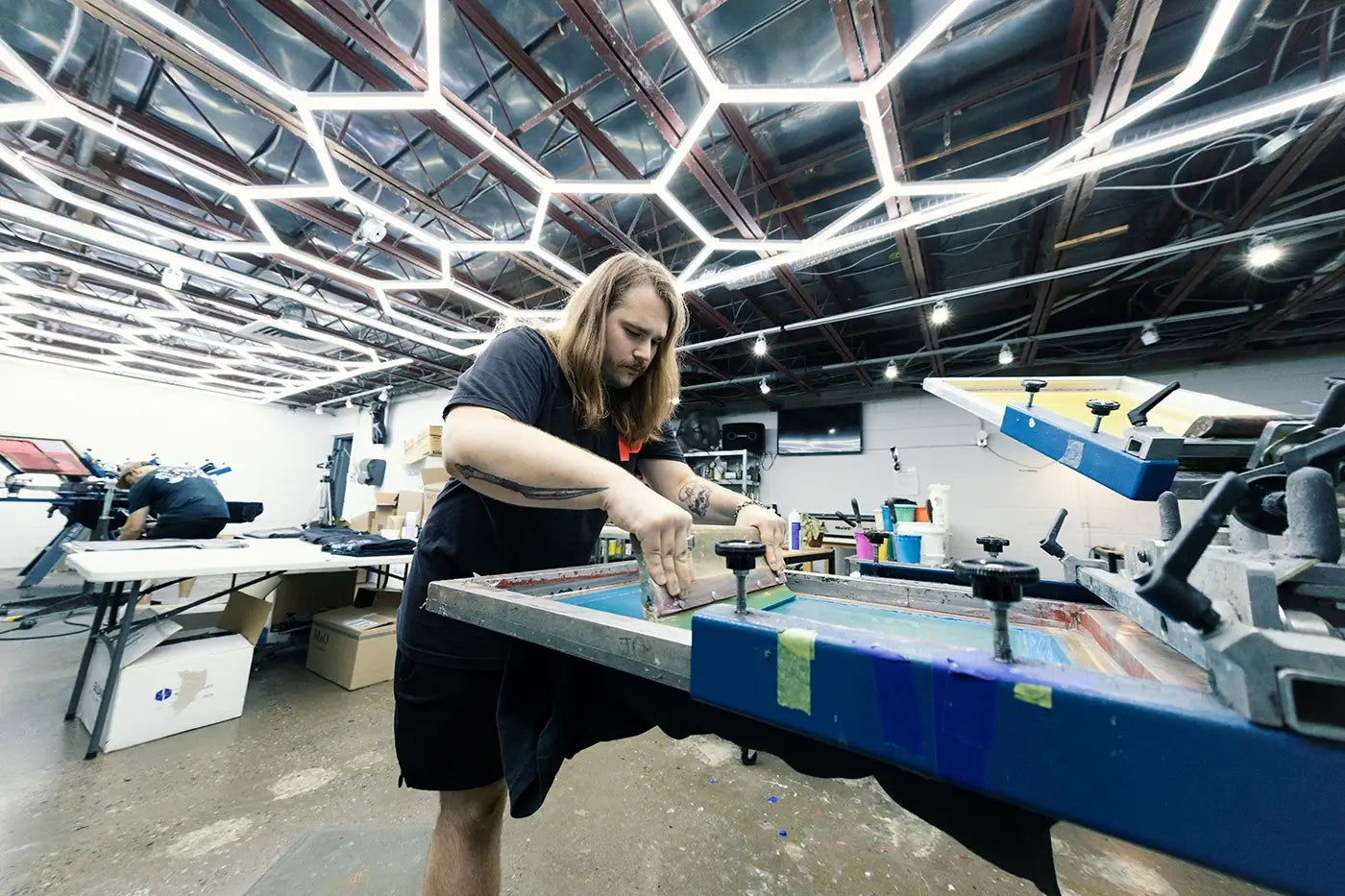Vintage Style Silk Screen Printing for Retro Fashion
Vintage Style Silk Screen Printing for Retro Fashion
Blog Article
Exploring the Art of Screen Printing: A Comprehensive Overview to Tee Shirt Printing Methods
When you tip right into the world of display printing, you're going into a domain where imagination fulfills workmanship. It's not simply regarding slapping ink on material; it's a thorough process that requires the right devices and methods.
The Basics of Screen Printing: Recognizing the Refine
Screen printing, frequently called serigraphy, is a versatile method that allows you to transfer styles onto different surface areas. To get begun, you'll initially require to develop a pattern, which offers as the foundation for your design. This involves using a light-sensitive solution to a display and subjecting it to light, where your artwork blocks the light from setting the emulsion.
As soon as you have actually washed out the unexposed areas, you'll have a stencil all set for printing. Next, you place the screen on your selected surface area, like fabric or paper. You then apply ink in addition to the screen and make use of a squeegee to press the ink via the stencil onto the surface area listed below. After printing, you'll require to cure the ink to assure it sticks properly. Understanding these fundamental steps establishes the stage for producing vibrant, lasting layouts through the art of screen printing.
Essential Tools and Products for Screen Printing
To start with screen printing, you'll need some key tools and materials. From the best devices to the inks and emulsions that bring your styles to life, each aspect plays an essential role. Let's explore what you need to succeed in this imaginative procedure.
Display Printing Devices
While diving into the world of screen printing, you'll uncover that having the appropriate equipment is vital for attaining top notch outcomes. Start with a sturdy screen printing structure, which holds the mesh that moves ink onto your textile. You'll also require a squeegee for pressing the ink via the mesh. When revealing your screens, a good top quality exposure system is important for creating sharp layouts. Do not forget a washout terminal for cleansing your screens after printing. Furthermore, protective gear like gloves and masks is very important for your safety and security. Spend in a trusted warm resource, such as a heat press or conveyor clothes dryer, to treat your prints effectively. With these devices, you're well on your method to mastering screen printing!
Inks and Emulsions
Selecting the right inks and emulsions is vital for achieving sturdy and lively prints. You'll want to pick inks based on your preferred coating and fabric type. t-shirt printing. Plastisol inks are preferred for their simplicity of usage and fantastic opacity, while water-based inks supply a softer feel and are much more eco pleasant
Solutions serve as a light-sensitive layer on your displays, essential for producing sharp stencils. By investing in the best inks and emulsions, you'll elevate your screen printing game considerably.

Devices for Application
You'll need a durable display, preferably made of aluminum or wood frameworks, along with a great mesh for proper ink transfer. A squeegee is crucial for applying pressure and spreading ink equally across the screen. With these tools, you'll be well-equipped for effective screen printing!
Traditional Screen Printing Methods
Typical screen printing strategies have actually stood the examination of time, showcasing the art and workmanship behind this popular approach. You'll usually begin with a stencil made from a fine mesh fabric extended over a framework. This mesh allows ink to pass with while obstructing locations you desire to continue to be unprinted. As soon as you've prepared your layout, you'll use a light-sensitive emulsion to the screen and reveal it to a light resource, hardening the solution where you desire ink to flow.
You'll after that put your screen on the tee shirt, use ink on top, and utilize a squeegee to push the ink via the mesh. This procedure can be repeated for multiple colors, needing separate displays for each. Mastering these methods gives you a solid foundation for all your screen printing ventures.
Modern Innovations in T-Shirt Printing
Today's tee printing landscape is humming with exciting technologies that are transforming how you produce layouts. With improvements in electronic printing, green products, and cutting-edge modification modern technologies, you can generate distinct, sustainable t-shirts like never before. Allow's explore these modern techniques and see how they boost your printing experience.
Digital Printing Improvements
As electronic printing technology has developed, it's transformed the landscape of T-shirt printing, offering you unprecedented precision and imagination. When almost difficult with traditional methods, you can now achieve complicated layouts with vibrant colors and intricate details that were. Direct-to-garment (DTG) printing permits you to publish straight onto material, making it excellent for little runs or customized layouts. Plus, the quick turn-around times mean you can react to fads and consumer needs quicker than ever before. With innovations in ink top quality, you can anticipate toughness and washability that equals display printing. This technology not only boosts your style possibilities but additionally opens doors for special artistic expressions, allowing your imagination beam on every Tee shirts you produce.
Eco-Friendly Products Usage
While exploring modern-day advancements in T-shirt publishing, you'll discover an expanding emphasis on environment-friendly products that prioritize sustainability without sacrificing high quality. Several brand names currently use natural cotton, which lowers chemical usage and advertises healthier farming practices. Recycled polyester, made from plastic containers, offers a resilient option that decreases link waste. Furthermore, water-based inks are obtaining popularity, as they generate less harmful drainage compared to typical solvent-based inks. These inks are not only much safer for the atmosphere yet also give vibrant shades and soft textures on material. By selecting these products, you add to an extra lasting garment industry while still taking pleasure in fashionable, top notch T-shirts. Accepting environmentally friendly choices permits you to share your worths through your closet.

Personalization Technologies Evolution
You currently have access to digital printing techniques like Direct-to-Garment (DTG) and Dye-Sublimation, which permit for elaborate layouts and vivid shades. These innovations make it simple to create distinctive items without the high costs of standard display printing. In addition, online style platforms encourage you to visualize your ideas before printing.
Selecting the Right Ink for Your Layouts
Just how do you pick the right ink for your screen printing designs? Begin by thinking about the kind of fabric you're working with. For cotton, water-based inks are optimal as they soak up well and offer a soft feel. If you're publishing on synthetic materials, plastisol inks offer toughness and vivid shades.
Following, consider the surface you desire. Matte inks provide a refined appearance, while shiny inks can add a striking sheen. If you're intending for eco-friendliness, select soy-based or water-based inks, which are much better for the atmosphere.
Don't ignore color mixing; some inks can be combined to create unique tones. Evaluate your inks on sample fabrics to validate compatibility and appearance before starting your primary task. Eventually, the ideal ink can make a significant difference in the quality and long life of your styles, so select sensibly!
Tips for Creating Stunning Tee Designs
Developing spectacular tee designs starts with a clear idea that reverberates with your audience. Consider what messages or motifs will certainly connect with them emotionally. Usage bold colors and appealing graphics to get focus. Keep in mind, simpleness typically functions best; messy designs can perplex visitors.
Include typography that reflects more helpful hints the personality of your brand-- pick typefaces that are readable yet trendy, and blend them intelligently. Take notice of placement; the style needs to flow naturally with the tee's form.
Try out different designs, such as vintage or contemporary, to locate what fits finest. Do not shy away from making use of unfavorable area effectively; it can produce a striking visual effect.
Finally, obtain comments! Share your layouts with close friends or possible customers to determine their responses (t-shirt printing). Their understandings can direct you in refining your work, ensuring your last design is not just sensational but likewise market-ready
Repairing Typical Screen Printing Challenges
When you run into challenges in display printing, recognizing the origin can make all the difference. If you Full Report see insufficient prints, inspect your screen for appropriate tension and verify your emulsion is fully treated. For smudging or fuzzy pictures, maybe because of improper ink thickness or not enough treating time; change your ink or remedy setups accordingly.
If you're dealing with shade mismatches, ascertain your ink mixing proportions and verify your screens are clean and totally free of residue.
Lastly, if you're experiencing training or peeling, take into consideration the sort of fabric you're making use of and the heat used throughout treating; various products call for specific inks and temperature levels. By attending to these common problems systematically, you'll boost your results and boost your self-confidence in display printing. Maintain trying out, and do not think twice to connect to fellow printers for suggestions and guidance.
Often Asked Inquiries
Can I Evaluate Print on Material Various Other Than Tee Shirts?
Absolutely, you can screen print on various textiles besides tees! Take into consideration products like shopping bag, hoodies, and even table linens. Simply guarantee you're utilizing the appropriate ink and devices appropriate for the material kind.
Just how Do I Tidy and Keep My Screen Printing Tools?
To cleanse and preserve your screen printing tools, on a regular basis clean screens with water and proper cleansers, inspect mops for damages, and shop every little thing in a completely dry, dust-free environment to extend its life-span and assure top quality prints.
What Is the Average Price of Starting a Display Printing Service?
Starting a display printing organization commonly sets you back in between $2,000 and $10,000. You'll require tools, products, and a work area. It's necessary to budget plan wisely and prepare for additional expenditures as your service grows.
Is Display Printing Eco Friendly?
If you choose sustainable materials and eco-conscious inks,Display printing can be eco pleasant. By adopting best methods and decreasing waste, you can minimize your influence while generating dynamic, top quality prints that interest conscious consumers.
Exactly How Can I Advertise My Custom Tee Shirt Layouts Effectively?
To promote your custom-made tee shirt designs successfully, take advantage of social media platforms, collaborate with influencers, run targeted ads, and engage your audience with giveaways or competitions. Constant branding and high quality visuals will certainly attract more consumers.
Checking out the Art of Screen Printing: A Comprehensive Guide to Tee Printing Strategies
Start with a durable screen printing framework, which holds the mesh that transfers ink onto your fabric. By spending in the ideal inks and emulsions, you'll raise your display printing game substantially.
With improvements in ink top quality, you can anticipate toughness and washability that matches screen printing.How do you choose the right ink for your display printing designs?
Report this page